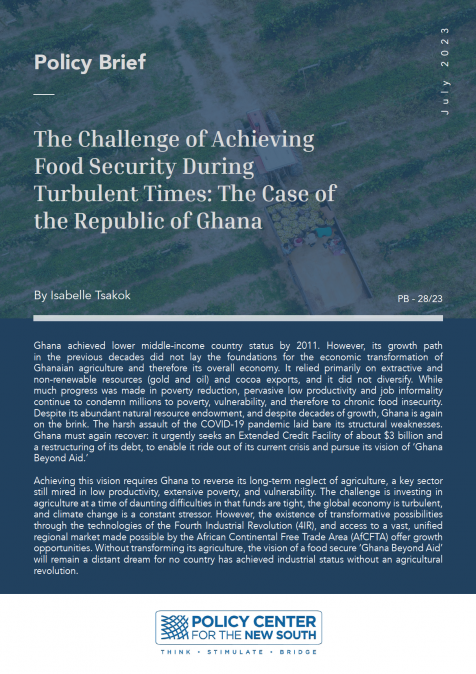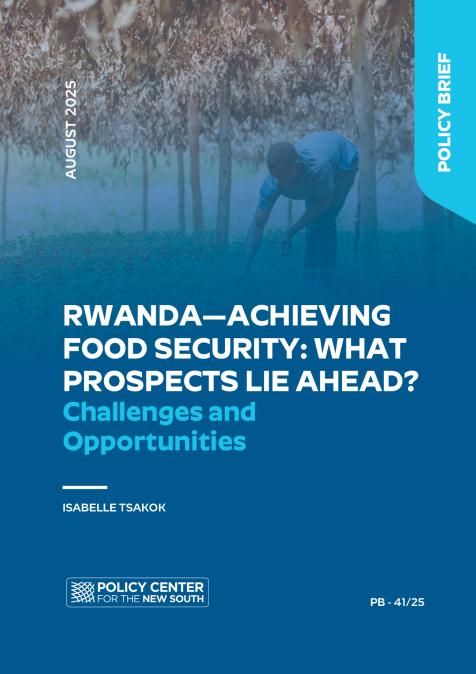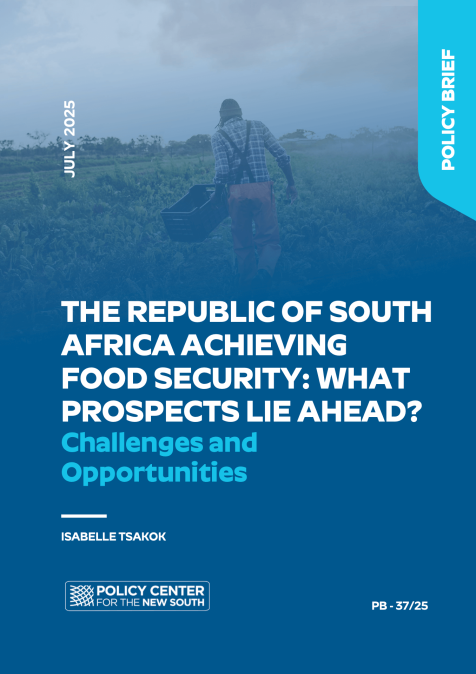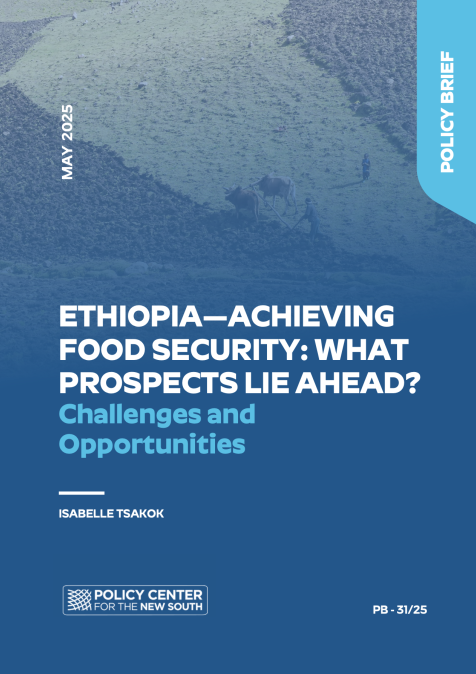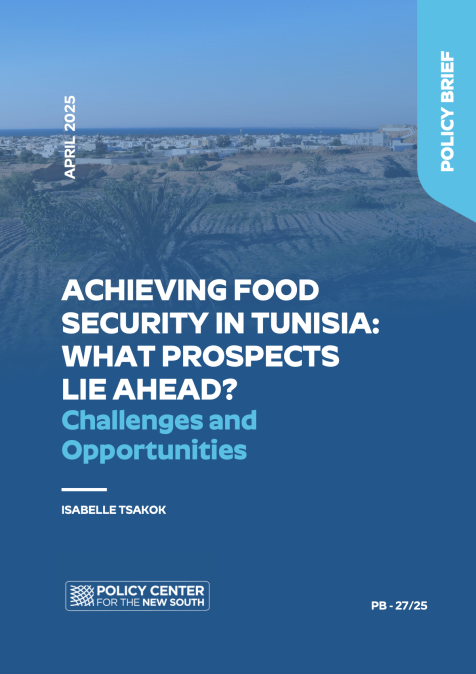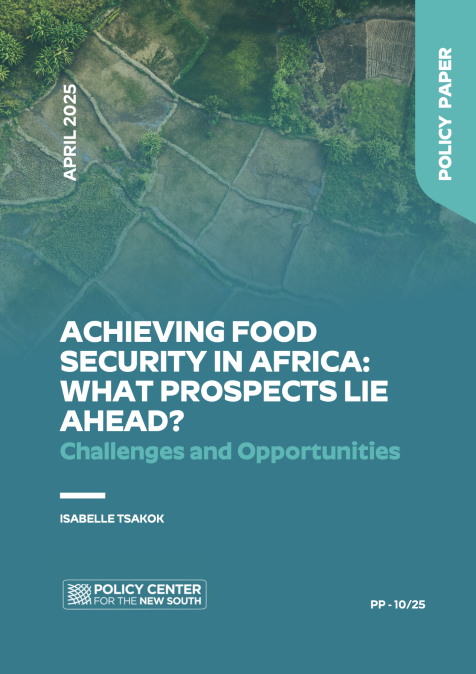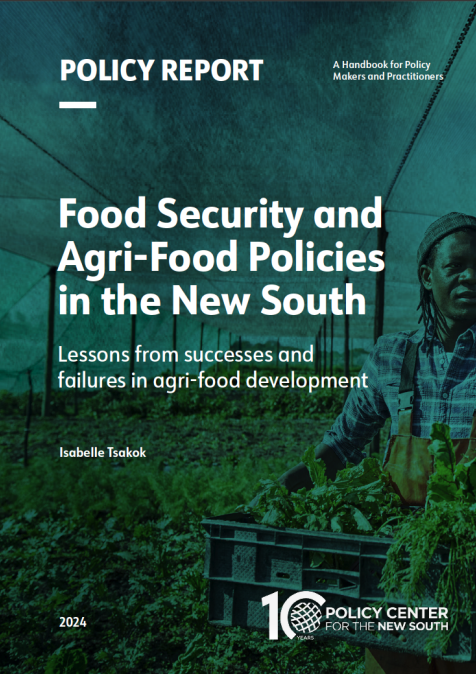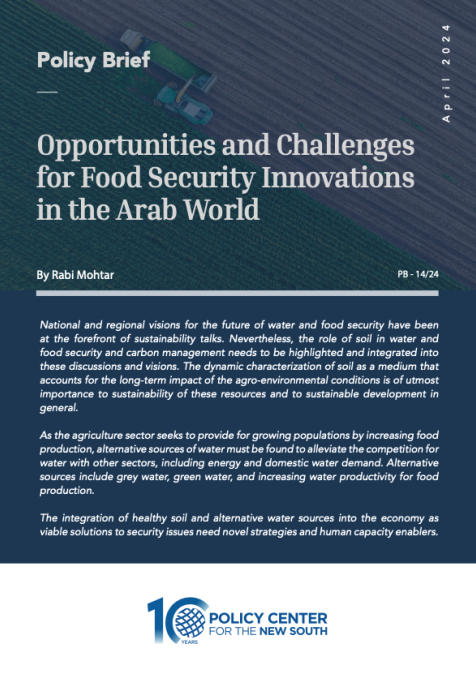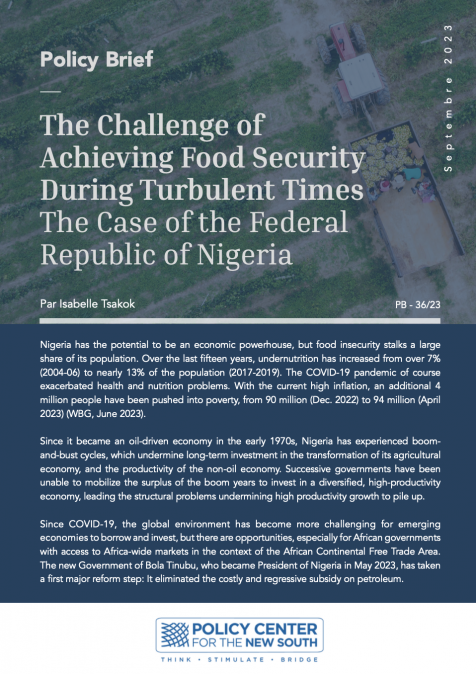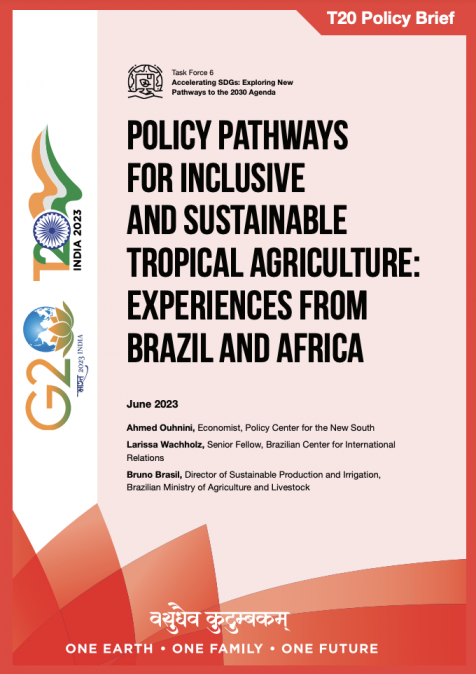Publications /
Policy Brief
Ghana achieved lower middle-income country status by 2011. However, its growth path in the previous decades did not lay the foundations for the economic transformation of Ghanaian agriculture and therefore its overall economy. It relied primarily on extractive and non-renewable resources (gold and oil) and cocoa exports, and it did not diversify. While much progress was made in poverty reduction, pervasive low productivity and job informality continue to condemn millions to poverty, vulnerability, and therefore to chronic food insecurity. Despite its abundant natural resource endowment, and despite decades of growth, Ghana is again on the brink. The harsh assault of the COVID-19 pandemic laid bare its structural weaknesses. Ghana must again recover: it urgently seeks an Extended Credit Facility of about $3 billion and a restructuring of its debt, to enable it ride out of its current crisis and pursue its vision of ‘Ghana Beyond Aid.’
Achieving this vision requires Ghana to reverse its long-term neglect of agriculture, a key sector still mired in low productivity, extensive poverty, and vulnerability. The challenge is investing in agriculture at a time of daunting difficulties in that funds are tight, the global economy is turbulent, and climate change is a constant stressor. However, the existence of transformative possibilities through the technologies of the Fourth Industrial Revolution (4IR), and access to a vast, unified regional market made possible by the African Continental Free Trade Area (AfCFTA) offer growth opportunities. Without transforming its agriculture, the vision of a food secure ‘Ghana Beyond Aid’ will remain a distant
Introduction
The Republic of Ghana (Ghana for short) has been hailed as a “rising growth star and a beacon of hope in West Africa” (World Bank Group (WBG), 2021). It reached lower middle- income country status in 2011, after sustained growth averaging 5% per year since the early 1990s. It achieved the first Millennium Development Goal (MDG) of halving poverty from 52.7% (1993) to 23.4% (2016), with extreme poverty declining from 36% (1991) to 8.2% (2016). It discovered offshore oil deposits and gas reserves in 2006, with reserves of at least 3 billion barrels of oil. Ghana started commercial oil production in 2011. After gold and cocoa, oil has become the third major source of export earnings.
Ghana’s latest offshore oil discovery highlights its abundant natural resource endowment. Ghana is one of the world’s top producers of gold—after all, as a Crown colony, it was known as the Gold Coast until independence from the United Kingdom in March 1957. It boasts of large deposits of diamonds, bauxite, and manganese. It also has unexploited deposits of iron ore, copper, chrome, nickel, limestone, quartz, and mica. Between 2013 and 2019, mining contributed directly to nearly 20% of GDP growth. The direct share of mining in total value-added rose from 3% of GDP in 2010 to 12% in 2018 (WBG, 2021).
Natural resources are not limited to mineral or non-renewable wealth; they also include land, soils, water, forests, coasts, and coastal fisheries. Ghana’s natural resource abundance has been a mixed blessing—a blessing in that mining activities, cocoa exports, and high commodity prices have powered much of its past growth; mixed because Ghana has not managed its natural resources in a way that builds developmental capital. Instead, it has been liquidating its non-renewable resources, and degrading its renewable resources. Ghana is now paying the high price of environmental degradation.
During good times (e.g., of high commodity prices), Ghana substantially reduced poverty and food security improved. But Ghana did not succeed during those decades in laying the foundations for the economic transformation required to substantially improve the incomes and therefore the food security of all its people. The key transformative processes that are required include: (i) increasing total factor productivity (TFP) growth in agriculture; (ii) diversifying and generating higher productivity, formal jobs for its burgeoning youth population; and (iii) managing its vast natural-resource endowment in a sustainable, climate-resilient, and inclusive manner.
This Policy Brief is about the challenge Ghana faces during these turbulent times: the challenge to grow, and strengthen the productivity, resilience, and inclusiveness of its economy. The PB first sets out key features of the global and country context within which Ghana must meet the challenge of achieving food security. The basic question is: Given this combination of turbulent times with opportunities for growth offered by transformative technologies and the African Continental Free Trade Area (AfCFTA), what is the challenge Ghana faces in achieving food security? “From a macro perspective, the two main drivers of food security, are household incomes and food prices” (Timmer, 2015). In other words, Ghana’s challenge is to raise household incomes and supply food at affordable prices. The successful transformation of agriculture is central to achieving both.
First, let us be clear about what achieving food security means: “Food security exists when all people, at all times, have physical and economic access to sufficient, safe and nutritious food that meets their dietary needs and food preferences for an active and healthy life” (World Food Summit, 1996). Food self-sufficiency2 and food sovereignty are not necessarily food security.
The Global Context: Multiple Global Crises But Also Transformative Technological Breakthroughs
Crises pile up: We live in turbulent times. The onslaught of the COVID-19 pandemic in 2020 was devastating in terms of health and economic wellbeing. It was soon followed by severe global crises of a geo-political nature. In particular, these crises include:
-
Supply-chain dislocations triggered by the pandemic, thus deepening economic distress and economic uncertainty the world over;
-
Costly government responses to counter the health and economic impacts of COVID-19. By 2021, an estimated 58% of the world’s poorest countries were in debt distress or at high risk of being so (World Bank Blog, 2022). All this has heightened the risk of global financial instability;
-
Russia’s invasion of Ukraine, which then inflicted food and fertilizer inflation, hurting poor countries the most, several already reeling from domestic conflict, natural disasters, and severe hunger;
-
Growing geopolitical tensions between Western democracies—NATO with the United States and Russia over its invasion of Ukraine; between China and the United States over Taiwan and islands near Japan, and in the South China seas;
-
Growing trade protectionism and deglobalization fragmenting world trade;
-
Millions of refugees fleeing from (a) collapsing governments and political persecution; (b) gang violence, economic deprivation, and years of drought; (c) natural disasters, conflict, and lack of economic opportunities; and (d) war. According to the UNHCR, an estimated 108.4 million people were forcibly displaced by the end of 2022.
-
Worsening of global hunger even before the pandemic. Thus:
-
Acute global hunger has been rising since 2014. It has worsened since the pandemic with an estimated 258 million people in 58 countries (as of May 4, 2023) facing acute hunger, up from 193 million in 2021. (World Bank, Food Security Update, May 4, 2023).
-
Prevalence of undernourishment (PoU) jumped from 8% to 9.3% of world population (2019-20) and to 9.8% in 2021 (FAO, 2022).
-
Some 703 million to 828 million people worldwide were undernourished in 2021, 150 million more since 2019, before the outbreak of COVID-19 (FAO, 2022).
-
In the outlook for the October 2022-January 2023 period, FAO-WFP warned of further deterioration of acute food insecurity in 19 countries, which are referred to as Hunger Hotspots.
-
These crises are all occurring against the background of climate change as it inflicts more frequent and more extreme weather events, including droughts, floods, forest fires, cyclones, typhoons, and heatwaves. In addition, the Horn of Africa and East Africa suffered from some of the worst locust swarms (the locust infestation is itself due to climate change) from around 2019 to 2022.
The potential of Fourth Industrial Revolution (4IR) technologies—disruptive and transformative: A bright spot is the transformative power of the technologies of the 4IR still being realized in the countries that have invested in them. 4IR technologies are distinguished by interconnectivity and communication between machines, sensors, people, and various devices, by the huge amount of data they collect and process to inform and facilitate decision making, and by the speed with which these processes take place. These technologies include:
-
The iPhone or smart phone
-
The internet of things (IoT)
-
Artificial intelligence (AI) and machine learning (ML)
-
3D printing
-
Robotics
-
Blockchain
-
Augmented (AR) and virtual reality (VR)
-
Driverless cars or fully autonomous vehicles
-
Nanotechnology
-
Biotechnology
These technologies ‘disrupt’ business as usual. Thanks to these technologies, ‘smart’ factories are no longer the realm of science fiction; sensors can detect impending equipment failure and help remove that equipment until it is repaired and fit for production again. In transportation and logistics, fleets of trucks, cars, ships, and trains can be re-routed based on up-to-date weather conditions, vehicle, and driver availability. More generally, these technologies can be used in many sectors to improve quality and timing, and reduce costs: e.g., service delivery in the public sector, inventory management and control in supply chains, monitoring of safety conditions in hazardous environments such as in chemical and power plants, and of hospital equipment assets and medical/personnel resources to benefit patient care.
Investment in physical and human capital essential for exploiting the potential of 4IR: Powerful machines require powerful humans to be in charge. Governments, private business, households, and individuals must be equipped, and thus empowered to understand the productive power of these 4IR machines. While all this is obvious, what is far from obvious is how best to mobilize the funds required for these investments in physical and human capital. This is a pertinent concern especially in fiscally-constrained countries where sustained productivity growth is essential. Ghana is one such country.
Ghana: GNI/Cap: $2,280 (Current $. 2021. Atlas method) (WDI) Ghana’s growth performance disastrous until the early 1990s
Poor growth performance soon after independence in 1957: The economy was primarily stagnant, reliant mainly on low-productivity agriculture (WBG, 2019). Under Nkrumah, the first president, Ghana adopted an import-substituting, state-led program of industrialization and farming. Nkrumah relied on high cocoa prices to finance his strategy, but cocoa prices plunged in the mid 1960s. Inevitably, the economy plummeted. Subsequent governments were unable to revive Ghana’s economy. GDP fell throughout the 1960s: per capita GDP shrank by 3.2% per year between 1970-1981 as the economy was caught in a disastrous succession of weak cocoa prices, crippling debt, and the increasing overvaluation of the cedi. During that period, production shrank on a wide front—e.g., cocoa, minerals, gold, diamonds. Government revenues also declined, the general standard of living plummeted, and poverty rose. The economy was in free fall.
Recovery in the 1990s but slow: In the 1980s, Rawlings took control of the government, and accepted the stringent loan conditions of the Economic Recovery Program (1983-91) of the IMF. The ERP emphasized economic stabilization in the early years, and included liberalization of foreign exchange (e.g., discrete, successive devaluations of the cedi) and of price controls, and the restoration of fiscal discipline. The significant progress since the 1990s included:
-
Real GDP more than quadrupled (World Bank, 2020);
-
GDP/cap has grown by an average of 3% per year since the 2000s (WBG, 2021);
-
Poverty rates declined substantially.
Despite improvements, inflation remained high at around 25%-30%. Institutional and structural reforms were put in place to increase the market-orientation and efficiency of the economy, but structural improvements were slow: the institutional rigidities in agriculture, finance and the parastatal sector remained. Renewable exports remained concentrated on cocoa. The improvement in private investment and saving was also slow (Nowak, IMF, 1996).
Poverty and vulnerability extensive, particularly in rural areas, despite substantial progress since 1991: In 1991, the vulnerable—those whose income was under 140% of the poverty line—were 73% of the total population; 82% were under 180% of the poverty line. In 2012,
the shares were much less—39% and 51% respectively (World Bank, 2015). Poverty has been predominantly rural: the poverty rate was 38.2% rural versus 10.4% urban (2012). Thus while 50% of the Ghanaian population was rural in 2012, it accounted for 78% of the poor. The incidence of poverty was highest among the communities living in the rural savannah (principally in the Northern, Upper West and Upper East regions). The poverty rate in the Northern region was 50.4%, accounting for 20.8% of all Ghana’s poor or 1.3 million poor people (2012). More generally, the rural/urban divide also widened as improvements in urban areas happened relatively more rapidly than in rural areas (World Bank, 2015). Inequality as measured by the Gini coefficient also increased from 0.38 (1991) to 0.42 (2016) (WBG, 2022). Extensive poverty and vulnerability inevitably undermine people’s resilience to shocks.
Nevertheless, there were some social improvements: Several non-monetary aspects of poverty have improved, e.g., assisted births, mortality, fertility, stunting, vaccination rates, and access to sanitation, electricity, and clean drinking water (World Bank, 2022). Other important indicators of improvement include: average life expectancy has increased from around 57 years (1991) to 65 years (2023); the literacy rate has increased from around 58% (2000) to 80% (2020); and primary and secondary school enrollment have increased, with the net primary school enrollment rate rising from 62.5% in 2000 to 86.0% in 2019.
Problematic Structure of Ghanaian Growth—Low Productivity and Lack of Diversification
Low productivity characterizes Ghanaian growth: From 1984 to 2011, 75% of growth in labor productivity was attributable to within-sector labor productivity growth, and only 25% to structural change, unlike the pattern of many high-growth Asian countries, and also unusual by the standards of Africa, where the movement of labor to higher-productivity sectors is an important source of growth in the early stages of a country’s economic transformation (IFPRI, 2019). From around 1990 to 2018, as agriculture’s contribution to GDP declined, the movement of labor was typically from low-productivity agriculture to low-productivity services in the informal sector. In fact, a quarter of Ghana’s labor force is employed in services with productivity lower than in agriculture. There has been an increase in manufacturing employment since 2010, but productivity in manufacturing has also declined. The economy remains undiversified; the growth drivers remain hydrocarbons, cocoa, and gold. Petroleum, gold, and cocoa account for more than 80% of total exports (WBG, 2018).
The growing importance of non-renewable resource rents undermines sustainable growth: Resource rents have contributed to an increasing percentage of Ghana’s GDP: from 6% of GDP in 1990 to 10% in 2000, to 18%-19% in 2011-12 (the first year the newly discovered oil was in full production), to around 13%-14% in 2017 (World Bank, 2020). The environmental cost to Ghanaian society of such growth is substantial. For 2007 GDP, it was estimated at $6.3 billion or 10.7% of GDP (World Bank, 2020). Sources of pollution to air (the most important) and water include mining (gold mines, unmanaged solid waste, and other contaminated sites), and agricultural land degradation, deforestation, and overfishing.
The pandemic highlighted and exacerbated Ghana’s structural weaknesses: Ghana’s structural weaknesses are undermining its ability to bounce back, especially within a turbulent global environment. These weaknesses were largely inherited from the incomplete implementation of reforms under the ERP (1983-91), with a failure to tackle, in particular, a low-productivity economy primarily reliant on non-renewable resource
ents, low-productivity and undiversified agriculture, the preponderance of informal-sector service jobs, and exports concentrated on gold, oil, and cocoa. With high fiscal deficits, public debt ballooned in 2020, reaching 78.9% of GDP, while the fiscal deficit rose to 15.2% of GDP (WBG, 2022). By late 2022, Ghana had an unsustainable public debt burden. The public debt is being restructured (World Bank, 2023).
The Challenge of Achieving Food Security During Turbulent Times
Ghana at a crossroads—fundamental re-orientation of its agricultural and rural policy necessary, though not sufficient, to generate an agricultural and economy-wide transformation: Ghana is in the throes of a pandemic- and debt-induced macroeconomic crisis. The pandemic-induced growth slowdown and subsequent high indebtedness have plunged Ghana into “a deep macroeconomic crisis” (World Bank, 2023). Ghana is urgently seeking a three-year Extended Credit Facility (ECF) of about $3 billion, and related debt restructuring. Way back, Ghana sought and received a financial and economic lifeline through the ERP (1983-91). Looking forward, the Government’s vision of a ‘Ghana Beyond Aid’ again requires changing course to transform the entire economy so that Ghana is no longer dependent on aid. This time, Ghana must find the productivity path to thrive ‘beyond aid’. This time, Ghana must “...realize the critical role of a modernizing agriculture in getting there. No country has succeeded in its industrial revolution without a prior (or at least simultaneous) agricultural revolution. Neglecting agriculture in the early stages of development is neglecting development” (Timmer, 2015). High-productivity agriculture, growing for decades, is necessary to achieve a ‘Ghana Beyond Aid’. Ghana is therefore at a crossroads because it must reverse its decades-long neglect of agriculture. From 1961-2021, Ghana never invested in agriculture anywhere close to the 10% of total public expenditure called for by the Maputo Declaration of July 2003. In the 2000s, public investment in agriculture has averaged only 2%-3% of total public expenditure, low even by African standards (IFPRI, 2019).
Agriculture and agribusiness could be major engines of productivity-driven growth and poverty reduction: Agriculture is a major sector, accounting for about 20% of GDP. It provides employment for nearly 50% of the labor force, and is the major source of livelihood for the poorest households. It provides raw materials for two-thirds of non-oil manufacturing (WBG, 2017). Agriculture and agri-business account for 25% of GDP, at least 50% of the national labor force, and 35% of exports. The main cash crop is cocoa, which occupies around 23% of total crop area, accounts for 7% of GDP, is the main agricultural export, contributing 20%-25% of total foreign exchange earnings, and 20% of total global cocoa exports. The cocoa beans are high quality and command a 3%-5 % market premium. But the trees are of low productivity: on around 23% of cocoa hectarage, the trees are over 30 years old, and for 7% of the hectarage, they have been attacked by the cocoa swollen shoot virus (CSSV). (WBG, 2017) From 1994-2013, output growth averaged 4.5% per year, with cocoa production growing at around 5.6% per year. (IFPRI, 2019) Low yields characterize both cash and food crops. Cereal yields, for example, are estimated at 1.7t/ha versus the regional average of 2t/ha, and potential in excess of 5t/ha (WDI, 2016). For food crops, actual yields as a % of potential yields range from 35% for maize to 57% for sorghum. For most staple crops, there is a 43%-66% yield gap. Average cocoa yields of 400-450 kg/ha are among the lowest in the world. The cocoa yield gap is estimated at more than 100%, which means that Ghana could produce more than twice what it actually does (WBG, 2017).
The huge unexploited productivity potential of agriculture in the north: The same huge unexploited potential is true of the Northern Savannah agro-Ecological Zone (NSEZ), which occupies over 54% of Ghana’s total surface area. The NSEZ also has significant irrigation potential. The region’s underdevelopment is indicative of wider problems in the sector, including inadequate infrastructure (roads and irrigation), complicated land-tenure arrangements, poor access to finance, and poor socio-economic indicators, including low education and skill levels. The semi-arid to arid climate makes this zone particularly vulnerable to weather extremes inflicted by climate change. (WBG, 2017)
Ongoing climate change threatens even lower productivity agriculture: The productivity situation can deteriorate further due to climate change. Because of climate change, average annual mean temperature has already increased by 1°C since 1960. Rainfall has become more erratic, and sea-level rise with changing hydrodynamics along the West African coast has led to coastal erosion. Weather and climate extremes have increased in frequency and magnitude, causing floods, droughts, and heat waves. All these are taking a toll in terms of lives lost and economic disruptions in urban and rural areas. Even at current low yields, most rainfed cereals, especially maize, can suffer further yield losses up to 16%-21% (during 2030-2050, compared to a baseline of no climate change); for other food crops, such as yams and cassava, plantains, and groundnuts, yield losses of 2%-6% could occur, along with a 13%-39% increase in livestock affected by droughts. Cocoa yields could also decline by 3% by 2030, and by 5%-7% by 2050, not to mention problems already being caused by the Cocoa Swollen Shoot Virus. (WBG, 2022)
Sustained investment in climate-smart agriculture and complementary measures are required to counter these losses and thrive: Widespread adoption of climate-smart agriculture (CSA) techniques and investment in digital technologies are required to enable farmers to adapt, survive, and even thrive in this changing climate. The techniques of crop and soil management are considered ‘smart’, because they enable farmers to adapt to the local changing climate conditions while increasing their productivity, making them more resilient to future climate change, and, where feasible, curb greenhouse gas emissions from agricultural production. To be effective as sustainable and higher productivity agriculture, CSA techniques must be complemented by substantial investments in human and physical capital impacting the majority of smallholders, as well as larger farmers. CSA is science- based which means the government needs to invest in research and extension to develop and disseminate CSA techniques for given agro-climatic and ecological zones of interest. Ability or inability to adapt can mean life or death for millions of farming households. CSA techniques also need to be complemented with infrastructure investments that enable good water control through storage and irrigation development, and access to expanding markets. The African Continental Free Trade Area (AfCFTA) offers a historic opportunity to access a vast regional market.
Climate change requires integrated resource management of agriculture, forestry, and water resources, to effectively address ecosystem degradation: The increased frequency and severity of extreme weather events increase soil erosion, land degradation, biodiversity loss, and deforestation. Warmer and drier temperatures also increase the risk of hazards such as forest fires, water shortages, and incidence of pests and diseases. In most areas of Ghana, wildfires occur frequently and up to 90% of the total area of the dry northern savannah is prone to annual bushfires, mainly caused by slash-and-burn agriculture. Ecosystem degradation is exacerbated by current poor water-management practices, land use change, population growth, and urbanization. Integrated resource management is not only a fundamental departure from current practices but would also require institutional coordination between multiple sectoral ministries, including the Ministry of Lands and Natural Resources (MLNR), Forestry Commission (FC), and EPA. In addition to institutional coordination, incentives at farm and community levels to invest in long-term natural regeneration and tree management are required. Currently, farmers have little incentive to invest in tree management as they lack rights to the trees. More generally, lack of land-tenure and tree-tenure security is a major obstacle to investing in the long-term fertility and productivity of the land, and therefore, to investing in sustainable land and soil management. Such insecurity not only undermines investment incentives, but it also makes investment virtually impossible as farmers cannot raise finance because they lack collateral.
The climate change threat is economy wide, not only for agri-food, forestry, and water resources: According to modelling by Hallegate et al (2016), even under an optimistic scenario of low climate impacts, climate change could reduce GDP by 9% and push over one million people back into poverty by 2030. This negative impact would be mainly experienced through decreasing agricultural revenues, increasing food prices, lower labor productivity, and increased prevalence of natural disasters and climate-related diseases such as malaria and diarrhea, leading to worse health outcomes. For example, without climate change the prices of maize and rice are projected to increase by 60% by 2030; with climate change, the increase is projected to be 153% and 121% respectively (WBG, 2021). Given the central importance of addressing climate change in a holistic manner despite the strained fiscal situation of a highly indebted Ghana, the proposal of “linking debt reduction to investments in climate adaptation and mitigation efforts” is promising and should be developed further. (Canuto et al, June 2023)
Conclusion
To realize its long-term vision of a ‘Ghana without Aid’, Ghana must effectively address the challenge of achieving food security for all. The bottom line is: Ghana must raise household incomes and supply food at affordable prices to all its people. The successful transformation of agriculture is central to achieving both. Now that Ghana is on the brink and times are tough, can it achieve both? Fortunately, history has inspiring examples of countries with dramatic turnarounds under the right leadership, strategy, sustained commitment, and luck. Ghana has a rich physical and human resource endowment as well as past successes that it can leverage to propel it forward.
Bibliography
-
Canuto, Otaviano, Hinh T. Dinh, Karim El Aynaoui, Hafez Ghanem, Badr Mandri. June 20, 2023. “External Debt Management in Africa: A Proposal for a ‘Debt Relief for Climate Initiative.’” Policy Center for the New South.
-
International Food Policy Research Institute (IFPRI). 2019. Ghana’s Economic and Agricultural Transformation: Past Performance and Future Prospects. Edited by Xinshen Diao, Peter Hazell, Shashidara Kolavalli, and Danielle Resnick. Oxford University Press.
-
FAO. June 2006. Policy Brief: Food Security. Issue # 2. https://www.fao.org/fileadmin/ templates/faoitaly/documents/pdf/pdf_Food_Security_Cocept_Note.pdf
-
FAO. 2022. The State of Food Security and Nutrition in the World. https://www.fao.org/3/ cc0639en/online/sofi-2022/food-security-nutrition-indicators.html
-
Reliefweb. Sept 21, 2022. “Hunger Hotspots: FAO-WFP early warnings on acute food insecurity, October 2022-January 2023 Outlook.” https://reliefweb.int/report/world/hunger- hotspots-fao-wfp-early-warnings-acute-food-insecurity-october-2022-january-2023-outlook
-
Nowak, M. 1996. Ghana, 1983-91. International Monetary Fund (IMF). https://www.elibrary. imf.org/display/book/9781557755667/C3.xml
-
Osei-Tutu, Eugene. Sept 30, 2020. “The Unemployed Youth Bulge of Ghana is a National Security Threat”. Modern Ghana. https://www.modernghana.com/news/1032785/the- unemployed-youth-bulge-of-ghana-is-a-national.html
-
Timmer, C. Peter. 2015. Food Security and Scarcity: Why Ending Hunger is so Hard. Center for Global Development and University of Pennsylvania Press, Philadelphia.
-
UNHCR – The UN Refugee Agency. Refugee Data Finder. Last Update: June 14, 2023.
https://www.unhcr.org/refugee-statistics/
-
WHO Corona Virus (Covid-19) Dashboard. As of May 10, 2023. https://covid19.who.int/
-
Williamson, Timothy. Dec 01, 2021. “History of Computers: A brief timeline”. https://www. livescience.com/20718-computer-history.html
-
World Bank. June 2015. Republic of Ghana: Poverty and Inequality Profile. Ghana Work Program (FY 2015) Report No: ACS13977. https://documents1.worldbank.org/curated/ en/258711468255281103/pdf/Ghana-Poverty-profile-final-2.pdf
-
World Bank. 2016. Shock Waves: Managing the Impacts of Climate Change on Poverty. https://www.worldbank.org/en/topic/climatechange/brief/shock-waves-managing-the- impacts-of-climate-change-on-poverty-background-papers
-
World Bank Group. June 20, 2017. Ghana: Agriculture Sector Policy Note—Transforming Agriculture for Economic Growth, Job Creation and Food Security. https://documents1. worldbank.org/curated/en/336541505459269020/pdf/119753-PN-P133833-PUBLIC- Ghana-Policy-Note-Ag-Sector-Review.pdf
-
World Bank Group. Nov 2018. Ghana: Priorities for Ending Poverty and Boosting Shared Prosperity—Systematic Country Diagnostic. Report No. 132010-GH. https://documents1. worldbank.org/curated/en/175681543268250421/pdf/132010-SCD-corrigendum-PUBLIC. pdf
-
World Bank Group. June 2019. Ghana: Economic Diversification through Productivity Enhancement. https://documents1.worldbank.org/curated/en/292511575924848299/pdf/ Ghana-Economic-Diversification-Through-Productivity-Enhancement.pdf
-
World Bank. April 2020. Ghana: Country Environmental Analysis. https://documents1. worldbank.org/curated/en/419871588578973802/pdf/Ghana-Country-Environmental- Analysis.pdf
-
World Bank Group. Nov 2021. Ghana Rising: Accelerating Economic Transformation and Creating Jobs. Ghana Country Economic Memorandum. Report No: AUS0002590 https:// documents1.worldbank.org/curated/en/178001636617909989/pdf/Ghana-Country- Economic-Memorandum-Ghana-Rising-Accelerating-Economic-Transformation-and- Creating-Jobs.pdf
-
World Development Indicators. (WDI) 2021. https://data.worldbank.org/indicator/NY.GNP. PCAP.CD?locations=GH
-
World Bank Group. Jan 2022. Country Partnership Framework for the Republic of Ghana for the period FY 22-26. Report No. 157249-GH https://documents1.worldbank.org/curated/ en/823041645721495743/pdf/Ghana-Country-Partnership-Framework-for-the-Period-of- FY22-FY26.pdf
-
World Bank Blog. June 28, 2022. “When the debt crises hit, don’t simply blame the pandemic”. By Marcello Estevão and Sebastian Essl. https://blogs.worldbank.org/voices/ when-debt-crises-hit-dont-simply-blame-pandemic
-
World Bank Group. Oct 2022. Ghana: Country Climate Development Report. https:// openknowledge.worldbank.org/server/api/core/bitstreams/9c9764c1-076d-5dcc-8339- 6e4f0de2b610/content
-
World Bank. Overview: Ghana. (Last updated March 31, 2023) https://www.worldbank.org/ en/country/ghana/overview
-
World Bank. April 01, 2023. Macro Poverty Outlook for Ghana. https:// documents1.worldbank.org/curated/en/099907204122391347/pdf/ IDU0e72b5e0b07a1d042650b9300cc751f35612d.pdf
-
World Bank. May 04, 2023. Food Security Update. https://thedocs.worldbank.org/en/ doc/40ebbf38f5a6b68bfc11e5273e1405d4-0090012022/related/Food-Security-Update- LXXXIV-May-4-2023.pdf?intcid=ecr_hp_headerE_en_ext

